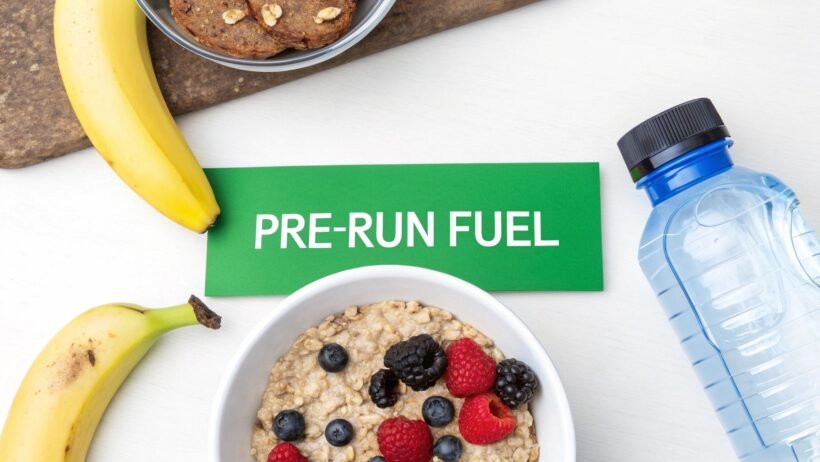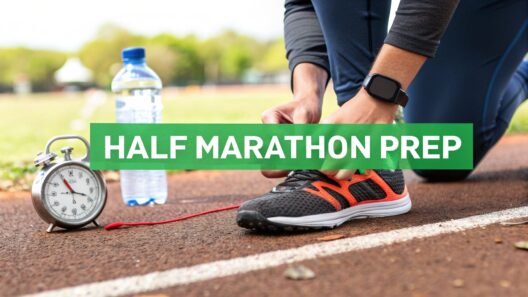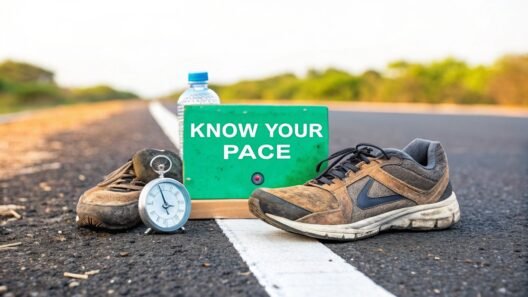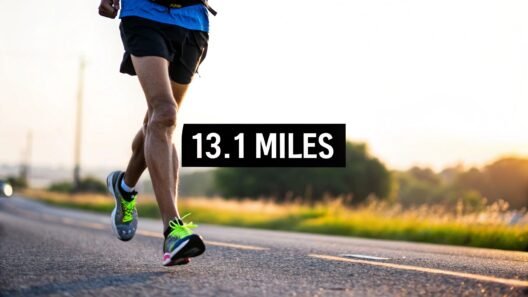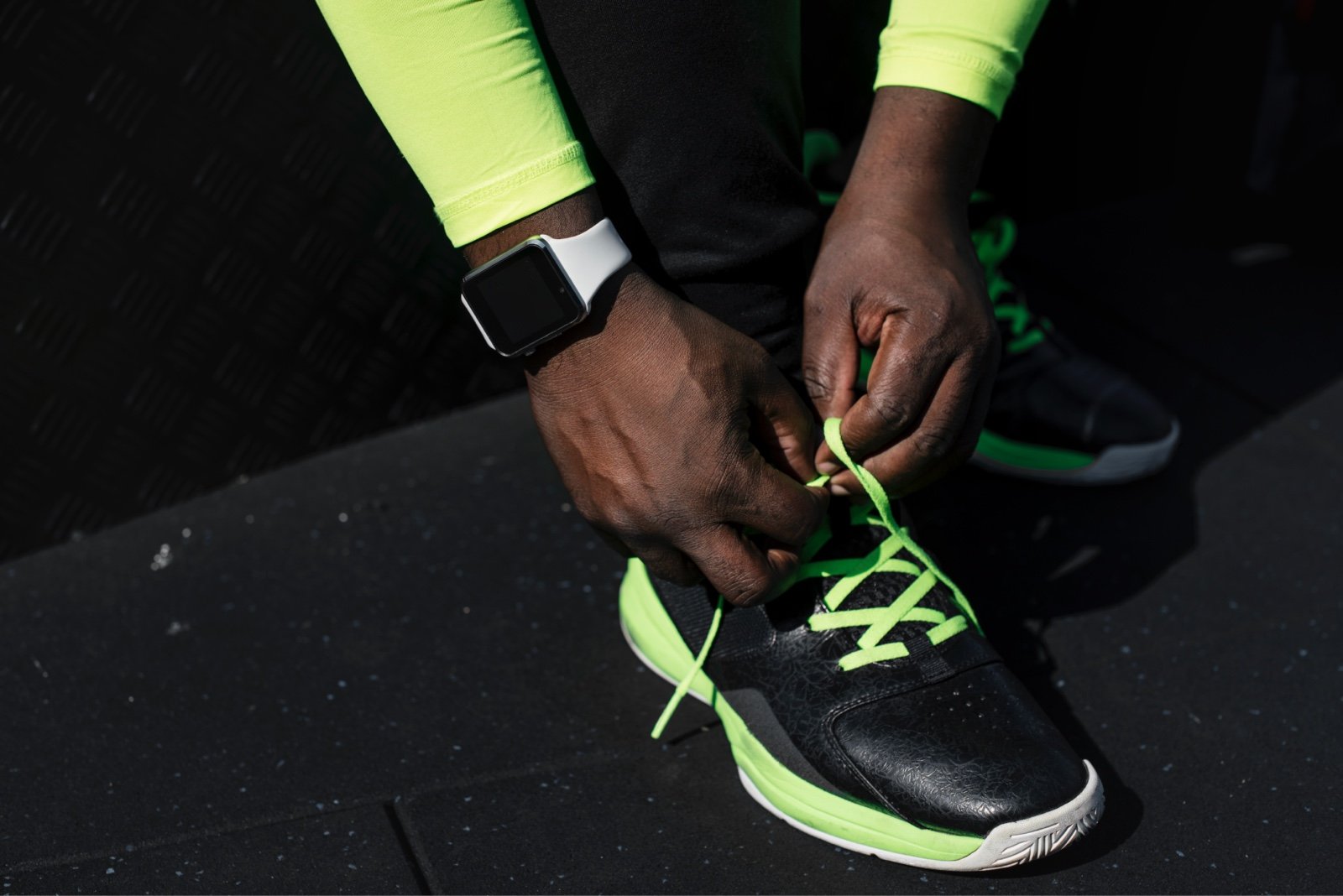Figuring out what to eat before a run can feel like a bigger puzzle than the run itself. If there’s one golden rule, it’s this: focus on easily digestible carbohydrates to make sure your energy tank is topped off. But the real secret weapon? It’s not just what you eat, but when you eat it.
Timing is everything. It's the difference between feeling light and energized or heavy and sluggish.
Your Pre-Run Fueling Blueprint
The key to a solid run isn't a single magic food. It's about giving your body the right kind of fuel at precisely the right time. Think of your pre-run nutrition as a flexible strategy that changes based on how much time you have before you head out the door. A full meal eaten hours before serves a totally different purpose than a quick snack grabbed on your way out.
The goal is always the same: maximize your stored energy (glycogen) and keep your blood sugar steady, all without upsetting your stomach. It's a balancing act.
Imagine you're fueling a car. A proper meal a few hours out is like filling the tank for a long road trip—it’s all about sustained, long-lasting energy. A smaller snack 30 to 90 minutes beforehand? That's just topping off the tank for immediate power, making sure you feel strong from the very first step.
The Three Critical Fueling Windows
Nailing these timeframes is the key to unlocking consistent performance. Each window calls for a different nutritional approach, shifting from complex, slow-burning meals to simple, fast-acting fuel as your run gets closer. For anyone just starting out, this can be a game-changer. Properly timing what you eat is a fundamental part of building an effective running schedule for beginners.
Here’s how to think about each window:
- 2+ Hours Before: This is your chance for a real, balanced meal. The focus here is on complex carbohydrates to fully stock your muscle glycogen, a moderate amount of protein for muscle support, and very little fat or fiber to avoid any digestive drama later.
- 30-90 Minutes Before: Now, your focus shifts to simple, easy-to-digest carbs. This is a strategic snack designed to give your blood sugar a little boost, providing a quick burst of energy to start your run strong without weighing you down.
- Under 30 Minutes Before: When you're really short on time, the goal is pure, immediate energy. We're talking simple sugars in a format that requires almost no digestion—think a gel, a few chews, or a couple of dates. It's a quick jolt to the system.
This decision tree helps visualize how your food choices should change as your run time approaches.

As you can see, the more time you have, the more complex your meal can be. The less time you have, the simpler and faster-acting your fuel needs to be.
Quick Guide to Pre-Run Fueling
To make it even simpler, here's a quick cheat sheet. Use this table as a starting point for planning your pre-run meals and snacks.
| Time Before Run | Primary Goal | What to Focus On | Example Foods |
|---|---|---|---|
| 2+ Hours | Maximize glycogen stores for endurance | Complex carbs, moderate protein | Oatmeal with fruit, chicken and rice, pasta |
| 30–90 Minutes | Top off energy & raise blood sugar | Simple, easily-digested carbs | Banana, toast with jam, small granola bar |
| Under 30 Minutes | Provide immediate, fast-acting energy | Simple sugars, minimal digestion | Energy gel, a few gummy chews, small sip of sports drink |
This table provides a great foundation, but remember that the best plan is the one that works for your body.
Tailoring Your Intake to Your Body
The amount and type of carbs you eat have a direct impact on your run. As a general guideline, sports dietitians often suggest a balanced meal with up to 4 grams of carbohydrates per kilogram of body weight when you have a good 2-4 hours to digest.
Get closer to your run, and that number drops. A smaller snack of around 1 gram of CHO/kg is a much better bet to prevent GI issues.
The most important rule is to find what works for you. Use these guidelines as a starting point, but don't be afraid to experiment during your training runs to discover your perfect pre-run meal. What works for one runner might not work for another.
By aligning your food choices with these timing windows, you can ensure your body is primed and ready to go, whether you're heading out for a quick 5k or tackling a long endurance run.
Fueling for a Long Run 2 to 4 Hours Out
When you have a generous two to four hours before a long run, you've hit the pre-fueling jackpot. This is your prime time to sit down for a real, balanced meal that will form the bedrock of your endurance. Forget scrambling for a last-minute gel; this meal is all about building deep, slow-burning energy reserves to carry you through every mile.
This isn't an excuse to stuff yourself to the point of discomfort. Think of it as making a strategic deposit into your body's energy bank. The goal is to top off your muscle glycogen stores—your primary fuel for any sustained effort—without causing any digestive drama once you start moving.
The Anatomy of the Perfect Pre-Run Meal
So, what should be on your plate? In this window, your meal should be dominated by complex carbohydrates. These are the marathon runners of the carb world, breaking down slowly to provide a steady stream of glucose to your working muscles. This approach prevents the dreaded energy spike and subsequent crash you’d get from simple sugars, helping you avoid "bonking" or hitting that wall.
Along with those quality carbs, you'll want a moderate serving of lean protein. Protein is great for muscle repair and also helps you feel full and satisfied, which is key to preventing hunger pangs an hour into your run.
Finally, you’ll want to keep fat and fiber to a minimum. While both are essential parts of a healthy diet, they slow down digestion quite a bit. Loading up on them before a run is a classic recipe for cramps, bloating, and other GI issues that can completely derail a great workout.
This meal is your secret weapon for conquering longer distances. It’s the difference between feeling strong and steady at mile 10 and wondering if you can even make it to the finish line.
Building Your Plate with Practical Examples
Let's get practical and talk about what this actually looks like on a plate. The most important rule? Stick to foods you know your system handles well. A long run or race day is never the time to experiment with that new spicy dish you've been wanting to try.
Here are a few of my go-to, tried-and-true meal ideas for the 2-4 hour window:
- A bowl of oatmeal made with water or low-fat milk, topped with a handful of berries and a sprinkle of cinnamon. Simple and effective.
- A grilled chicken breast with a medium-sized sweet potato and a side of steamed green beans.
- A turkey and avocado sandwich on whole-wheat bread. Just make sure the bread isn't one of those super high-fiber varieties.
- A plate of pasta with a simple tomato sauce and a small portion of lean ground turkey.
- Two scrambled eggs with a side of whole-grain toast and a small banana.
Getting the Portions Right
Knowing what to eat is only half the battle; knowing how much is just as important. Instead of getting bogged down with counting every last gram and calorie, try using these simple hand-based cues to build your plate.
- Carbohydrates: Aim for a portion about the size of one to two of your cupped hands.
- Protein: A serving roughly the size of your palm is a great starting point.
- Fats: Limit any added fats to about the size of your thumb (think a small slice of avocado or a teaspoon of olive oil).
This is a straightforward way to build a balanced meal without needing a food scale. It's incredibly practical, whether you're at home or traveling for a race.
The Underfueling Trap for Long Distances
While focusing on the right foods is crucial, it’s just as important to eat enough. So many runners, especially those training for big endurance events, accidentally under-fuel. When you’re tackling longer distances like a half-marathon, proper fueling simply isn't negotiable. If you're new to that distance, our guide on how many miles are in a half-marathon can give you some valuable context on the demands you're facing.
This isn't just a hunch I have from years of running. Research consistently shows that athletes fall short of recommended carb intake. One study on amateur marathoners, for instance, found their average pre-race carbohydrate intake was a mere 1 gram per kilogram of body weight. That’s way below the 3–4 g/kg experts recommend for optimal performance 3–4 hours before a race. You can read more about these pre-race fueling findings and see just how big the gap can be.
This meal is your single biggest opportunity to load up on the fuel you’ll need to perform your best. Don't be afraid to eat a satisfying, substantial meal. Your body will thank you for it later.
The 90-Minute Pre-Run Sweet Spot

Let's be realistic. Most of our runs aren't preceded by hours of meticulous meal planning. They happen when life lets them—squeezed in before work, during a lunch break, or as the sun goes down.
This reality lands most of us squarely in the 30-to-90-minute pre-run window. A full meal is completely out of the question, but trying to run on an empty tank isn't the right move either. This is the sweet spot, where the right snack can make all the difference.
Your mission here is simple: give your body quick, easy-to-access energy that won't weigh you down or send your stomach into a rebellion mid-stride. Forget the slow-burning complex carbs from a big meal. We're talking about simple, easily digestible carbs that top off your blood sugar and get you out the door feeling strong.
Mastering the Pre-Run Snack
In this timeframe, your snack needs to be low in fiber, fat, and protein. Why? Because these three things are the enemies of quick digestion. While they're great hours before a run, they’re the last thing you want when you're about to start moving. They can lead to that heavy, sloshing feeling in your stomach or, even worse, dreaded cramps and side stitches.
Instead, fast-acting carbohydrates are the star of the show. Your goal should be around 30 to 60 grams of carbs for a noticeable energy boost that doesn't overwhelm your system.
Think of it this way: your muscles already have glycogen stored from past meals. This quick snack is like a shot of high-octane fuel, ensuring your brain and muscles have readily available glucose from the very first step.
Here are a few classic, runner-tested options that get the job done:
- A medium banana: A runner’s best friend for a reason, providing about 27 grams of simple carbs.
- A slice of white toast with jam: This gives you a pure carbohydrate hit without much fiber to slow things down.
- Small bowl of instant oatmeal: Made with water, it's typically lower in fiber than steel-cut oats and digests easily.
- Handful of pretzels or graham crackers: Simple, dry, and incredibly easy on the stomach.
Your goal is to choose something familiar and reliable. The 90-minute window before a run is not the time to experiment with that new high-fiber energy bar you just bought. Stick with what you know works.
Finding Your Perfect Snack
The examples above are solid starting points, but the real magic happens when you figure out what works for your body. What one runner swears by might send another running for the nearest bathroom.
Use your regular training runs as a personal food lab. Does a thin layer of peanut butter on your banana work for you? For some runners, that small bit of fat and protein helps prevent a blood sugar crash and provides a more sustained energy release. For others with more sensitive stomachs, it’s a recipe for disaster.
This is where you have to become a student of your own body. Pay attention to how you feel a mile into your run. Energized? Sluggish? Feeling a cramp coming on? Keep a mental log of what you ate and how it made you feel.
Don't Forget to Hydrate
Fuel isn't just about food—hydration is just as critical. In this 90-minute window, the key is to sip, not chug. Try to drink about 8 to 16 ounces (240-475 ml) of water in the hour leading up to your run.
For most runs under an hour, plain water is perfect. It does the job without adding any extra sugars your body doesn't really need for that shorter effort.
But if you're heading out for a longer run (over 60-75 minutes) or it’s a brutally hot and humid day, an electrolyte drink might be a smart move. The added sodium and minerals help your body absorb and hold onto fluid, which can be a game-changer for preventing dehydration and muscle cramps. This is especially true if you're a "salty sweater" and often find white, crusty streaks on your clothes post-run.
The "Oh Crap, I Need to Run Now" Fueling Plan (0-30 Minutes)

Let's be real—sometimes the perfectly planned schedule goes right out the window. A meeting ends early, the kids are finally quiet, and a small, glorious window opens up for a run. You have to go now.
When you've got 30 minutes or less, the rules change. We're no longer talking about building endurance stores; this is about getting a quick, immediate spark to avoid starting on empty. Your goal is a shot of pure, simple energy that your stomach barely has to look at to digest.
Keep It Simple, Seriously
With the clock ticking, your digestive system is not your friend. Anything that takes time to break down is going to cause problems once you start pounding the pavement. I'm talking about the big three culprits of mid-run stomach trouble: protein, fat, and fiber.
All three of these dramatically slow down how quickly food leaves your stomach. The result? That dreaded sloshing, cramping, and the side stitches that can ruin a run. Think of it as creating a traffic jam right when you need the express lane open.
This means you need to avoid things like nuts, yogurt, or even most energy bars. They just have too much going on. Your focus needs to be on simple sugars that are absorbed almost instantly.
Your last-minute fuel isn’t a meal. It's a jolt. Think of it as a splash of gas to get you out of the driveway and through the first few miles, so you start strong instead of sputtering.
Grab-and-Go Lifesavers
When time is short, your food needs to be just as fast. The best options are often pre-packaged and specifically designed for this exact purpose. You're aiming for a small, easily digestible hit of about 15 to 30 grams of carbohydrates.
Here are some of my go-to choices that runners have relied on for years:
- An energy gel or a few energy chews: This is literally what they were invented for. They deliver a precise dose of simple sugars like maltodextrin that your body can absorb in a flash.
- A couple of dates or a spoonful of honey: Nature's energy gels. Both are fantastic sources of simple, natural sugars that give you a very quick lift.
- A small handful of pretzels: They're just dry, low-fiber carbs. Incredibly easy on the gut.
- A small glass of sports drink: A liquid source of sugar is one of the fastest ways to get fuel into your bloodstream. Just 4-6 ounces will do the trick.
Remember, the point isn't to feel full. It's to give your system a small, targeted energy boost to get you going.
Why This Works in a Pinch
So, what's the magic behind these simple sugars? When you eat them, your body breaks them down into glucose—its favorite form of energy—almost immediately. That glucose hits your bloodstream fast, providing a ready-to-use source of fuel for your muscles.
It's a world away from complex carbs, which have to go through a much longer digestive process before they become usable energy. In this tiny window, your body just doesn't have time for all that. By choosing something fast and simple, you bypass the digestive drama and send fuel right where it needs to go.
Solving Common Pre-Run Fueling Problems
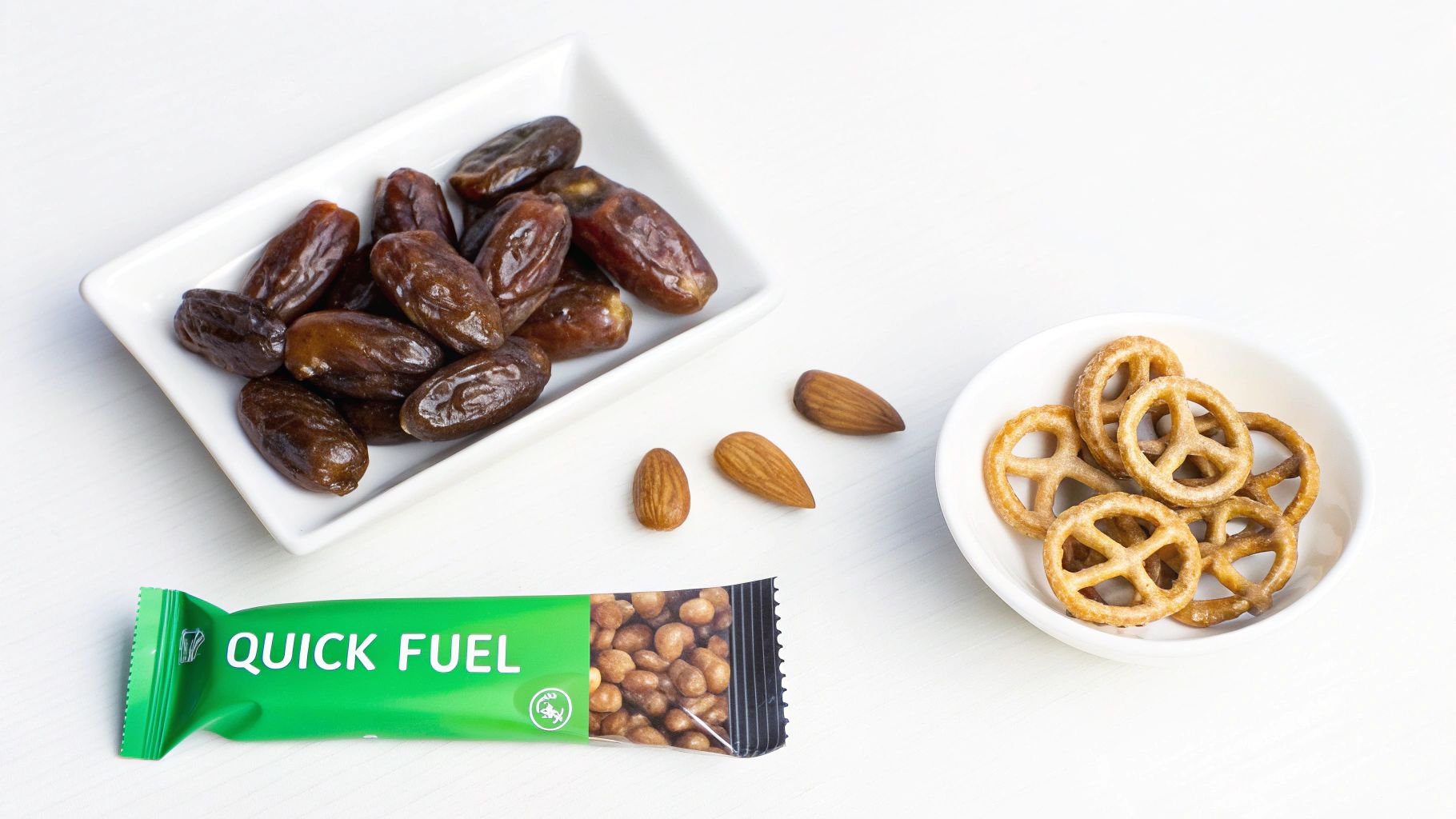
Even with the best plan, sometimes your pre-run fuel just doesn't sit right. We’ve all been there. What worked perfectly for last week’s run suddenly feels completely wrong today. That's running for you.
Learning how to troubleshoot these common issues on the fly is just as important as knowing what to eat in the first place. Let’s walk through the real-world problems runners face every day—from the 5 a.m. wake-up call to that dreaded mid-run stomach cramp—and how to fix them.
The Early Morning Runner's Dilemma
Waking up before the sun for a run creates a unique fueling puzzle. You need energy, but a full breakfast is the last thing you want (and you definitely don't have hours to digest). The trick is to find a small, simple, and fast-acting source of carbs that you can get down without a fuss.
A few of my go-to options for the early bird are:
- A small banana: It's called nature's energy bar for a good reason.
- A couple of dates or a spoonful of applesauce: Both give you a quick hit of natural sugar.
- A handful of dry pretzels or a graham cracker: Simple, easy to digest, and very low in fiber.
Your pre-run fuel strategy for a morning run actually starts the night before. Make sure your dinner included a solid portion of complex carbohydrates like sweet potatoes, quinoa, or whole-grain pasta. This helps top off your glycogen stores overnight, so you're not starting on an empty tank.
Decoding and Defeating GI Distress
Nothing ruins a great run faster than gastrointestinal (GI) distress. That sudden side stitch, the bloating, the panicked search for a bathroom—it’s the worst. More often than not, the culprit is eating the wrong thing at the wrong time.
The most common triggers are foods high in fiber, fat, and dairy. They just take too long to digest and can wreak havoc once you start moving. Think about your last pre-run snack. Was it a high-fiber granola bar? A bowl of yogurt? Those are frequent offenders.
Here's a pro tip: You can "train your gut" just like you train your legs. Start by introducing very small amounts of fuel during your easier runs. Over time, you can gradually increase the amount or try different foods as your digestive system adapts to working while you're in motion.
This process helps your body learn to manage blood flow to both your muscles and your stomach, which is key to avoiding cramps and discomfort down the road.
The Fasted Running Debate
Running on an empty stomach, or "fasted running," is a pretty hot topic. Some runners swear by it for their easy morning jogs, believing it helps their body get better at burning fat for fuel.
For a short, low-intensity run—think 30-45 minutes at a pace where you can hold a conversation—running fasted is generally fine for most people. Your body has enough stored glycogen to handle that effort without needing more fuel.
However, for anything longer or more intense, like a tempo run, interval session, or your weekly long run, fasted running is a bad idea. You’ll force your body to break down muscle for energy, spike stress hormones like cortisol, and put yourself at high risk of "bonking." Always fuel for performance.
Your Pre-Run Meal Can't Fix In-Run Neglect
Finally, let's get one thing straight: a perfect pre-run meal can't make up for poor fueling during a long run. Your glycogen stores are finite. Once they’re gone, they’re gone.
This is where in-run nutrition—gels, chews, and sports drinks—becomes essential. For any run lasting longer than 75-90 minutes, you have to start replenishing carbohydrates to maintain your energy and performance.
It's amazing how many athletes struggle with this. For ultra-endurance events, studies show only about a third of runners actually hit the in-race recommendation of at least 40g of carbs per hour. Despite all the sports nutrition advice out there, under-fueling is still a massive issue, often because of the simple challenge of carrying and consuming food on the move. You can learn more about these in-race fueling habits to see why planning is so critical.
Think of it this way: your pre-run meal gets you to the starting line and through the first hour. After that, your in-run nutrition plan has to take over.
We've covered some common scenarios, but sometimes a quick-reference guide is what you really need. Here’s a simple table to help you diagnose and solve the most frequent pre-run eating issues.
Fixing Common Pre-Run Eating Issues
| Problem | Potential Cause | Actionable Solution |
|---|---|---|
| Side Stitches / Cramps | Eating too close to your run; too much fat or fiber. | Wait at least 60-90 minutes after a small meal. Stick to simple, low-fiber carbs like a banana or white toast. |
| Feeling Sluggish / Heavy | Meal was too large or high in fat/protein. | Reduce portion size. Focus on easily digestible carbohydrates and save the bigger meal for post-run recovery. |
| "Bonking" (Hitting the Wall) | Not enough carbohydrates before a long or intense run. | Increase your pre-run carb intake. For runs over 90 minutes, ensure you had a substantial carb-focused meal 2-3 hours prior. |
| Nausea or Bloating | Too much sugar, fiber, or dairy; dehydration. | Avoid sugary drinks and high-fiber bars. Sip water steadily beforehand instead of chugging it right before you leave. |
| Mid-Run Bathroom Emergency | High-fiber foods, caffeine, or artificial sweeteners. | Cut out high-fiber cereals, beans, or certain fruits before your run. Test your caffeine tolerance on shorter runs first. |
Keep this table handy. Sometimes, seeing the problem and solution laid out so clearly is all it takes to dial in your nutrition and have a much better run next time.
Frequently Asked Questions About Pre-Run Fueling
Alright, you've got the basics down on timing and macros, but running nutrition isn't always that simple. Real-world running brings up very specific questions, and sometimes you just need a straight answer from someone who's been there.
Let's dive into some of the most common fueling puzzles runners face. I'll give you clear, no-nonsense advice to help you dial in the details of your own pre-run routine.
How Much Water Should I Drink Before a Run?
Hydration is a tricky balance. You want to be hydrated enough to perform well, but not so full that you're sloshing your way through the first mile. There’s no magic number here; it really depends on the weather, how long you're running, and how much you personally sweat.
As a general guideline, focus on sipping water consistently all day long. In the 2 to 3 hours leading up to your run, try to get in about 16 to 24 ounces (475-700 ml). This gives your body plenty of time to absorb the fluid and flush out anything it doesn't need.
About 15 to 30 minutes before you head out the door, take a final few sips—around 4 to 8 ounces (120-240 ml) is perfect. This little top-off ensures you start with a full tank. If it's hot and humid, or if you know you're a heavy sweater, dropping an electrolyte tablet into your water can be a game-changer for staying hydrated.
Is Coffee Good or Bad Before a Run?
Ah, the age-old coffee question. For a huge number of runners, myself included, a morning coffee before a run is an absolute must. And there's good science to back it up. Caffeine is a proven performance aid that can make you feel more alert, lower your perception of effort (making tough runs feel easier), and help your body tap into fat for fuel.
The key is getting the timing and dose right. Aim for 100-200 mg of caffeine, which is about what you'd get in a small cup or two of coffee. Drink it 45 to 60 minutes before your run to give it time to kick in.
But here’s the big "if": coffee can also be a gut-wrecker for some people, causing bathroom emergencies you definitely don't want mid-run. You have to test this out on training days, never on race day. If it bothers you, try a smaller amount, or look for a low-acid blend. Remember, a solid performance plan includes more than just fuel—it's also about having the right equipment. If you're dealing with specific issues, checking out our guide on the best running shoes for flat feet can be just as crucial as what's in your coffee cup.
The golden rule for pre-run caffeine: If it works for you, it’s a powerful tool. If it causes you GI distress, it’s not worth the potential performance boost. Experiment during training to find your sweet spot.
How Does Fueling Differ for Training vs Race Day?
This is a fantastic question, because while the food might be the same, the mindset is completely different. Think of your training runs as your personal nutrition lab.
Training Runs: This is your playground. Use these runs to test everything. Try different snacks, play with timing, and see how various hydration strategies feel. It’s a low-pressure way to figure out exactly what works for you and, just as importantly, what definitely doesn't.
Race Day: This is showtime. Race day is absolutely not the time to try that new gel you saw at the expo. The goal is to be predictable. You execute the exact fueling plan that you have practiced and perfected over weeks of training.
You’ll eat the same trusted meal or snack at the same time before the gun goes off. The only small change might be a more focused effort on carb-loading in the few days leading up to a marathon or half marathon to make sure your glycogen stores are topped off.
At THE RUNNING, we believe that becoming a stronger, healthier runner starts with knowledge. Our platform is your complete guide to better running, offering everything from training plans and gear reviews to expert advice on nutrition and injury prevention. Discover everything you need for your running journey at https://www.the-running.com.



